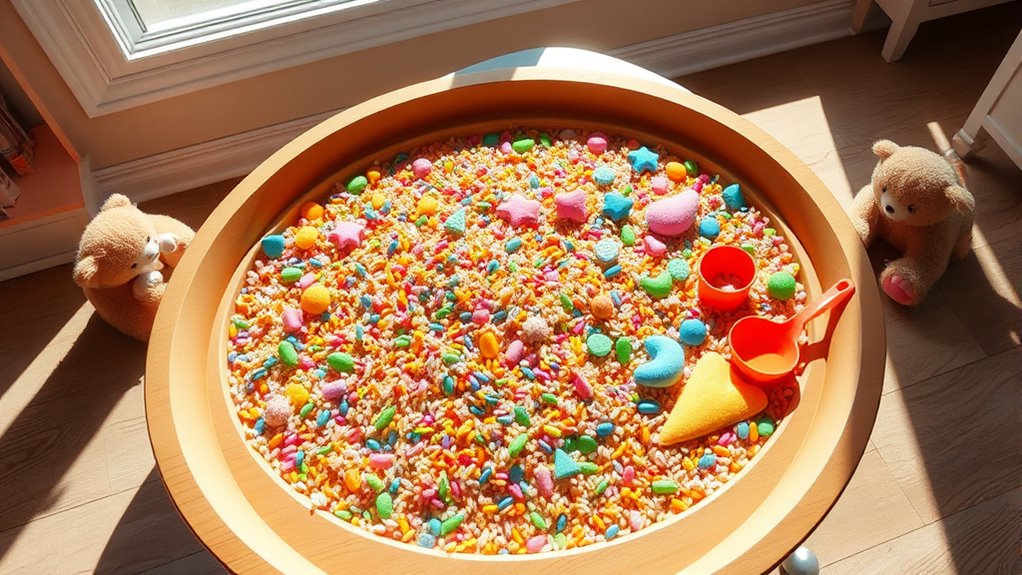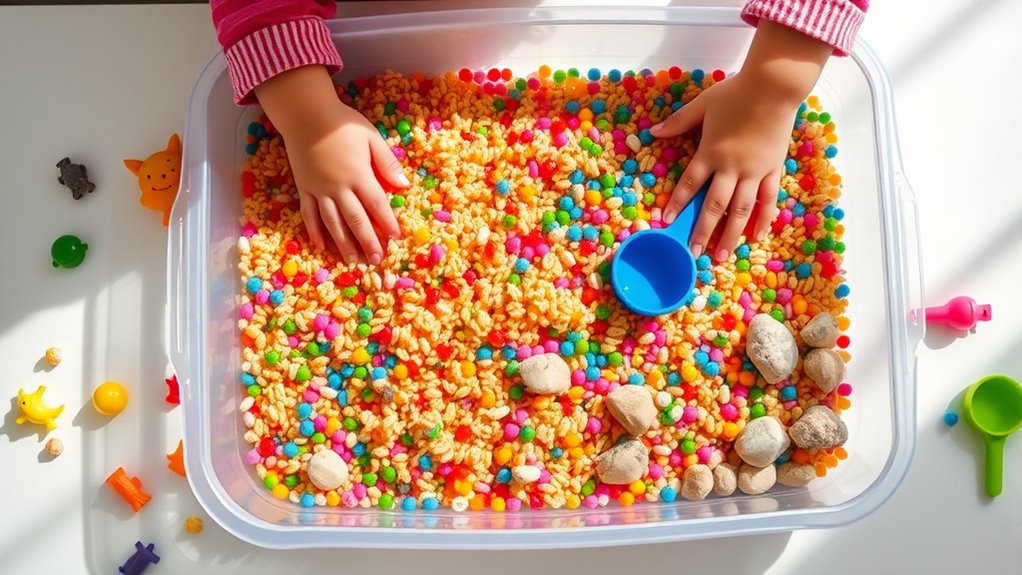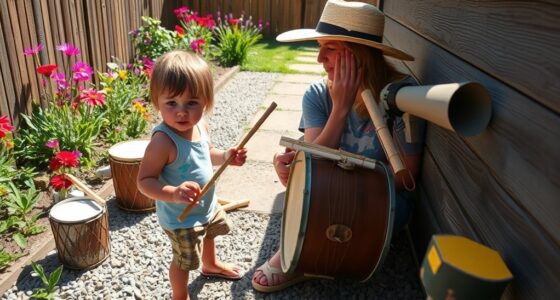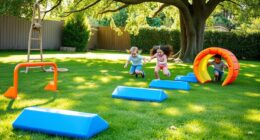Sensory bins are great tools for hands-on learning, helping children explore textures, improve fine motor skills, and develop sensory regulation. To set them up, choose a sturdy container, fill it with safe base materials like rice or sand, and add themed toys or objects suited for their age. Always supervise, use non-toxic materials, and make certain items are safe and large enough. Keep exploring to discover more tips for creating engaging and safe sensory experiences.
Key Takeaways
- Use a sturdy container with safe, textured materials like rice or beans to create engaging sensory experiences.
- Supervise play and select age-appropriate, non-toxic objects to ensure safety and prevent choking hazards.
- Incorporate varied textures and themed toys to support sensory development and stimulate curiosity.
- Set up the sensory bin in a clutter-free area, establishing rules for safe exploration such as no throwing or mouthing objects.
- Sensory bin play enhances fine motor skills, cognitive growth, language development, and sensory regulation through hands-on exploration.

Sensory bins are versatile tools that can boost your child’s development while providing endless fun. They offer a tactile experience that encourages exploration and learning, making them a favorite activity for both parents and children. One of the key benefits of sensory bins is their ability to enhance fine motor skills. When your child scoops, pouring, and grasping objects within the bin, they strengthen the small muscles in their hands and fingers. These movements are essential for developing skills like writing, buttoning, and tying shoelaces. Sensory bins also support sensory integration, helping your child process and respond to different sensory stimuli more effectively. This is especially beneficial for children with sensory processing challenges, as the variety of textures, colors, and shapes can help them become more comfortable with new sensations and improve their overall sensory regulation.
Setting up a sensory bin is straightforward. You start with a sturdy container—like a plastic storage bin or a shallow box—that’s large enough for your child to move around and explore easily. Fill it with a base material such as rice, pasta, beans, or sand, which provides a tactile foundation. Then, add themed objects or toys that match your child’s interests or learning goals, like small figures, scoops, cups, or utensils. It’s important to choose items that are age-appropriate and safe, avoiding small parts that could pose a choking hazard. Keep the setup simple but versatile so your child can explore different ways to interact with the materials. Incorporating different textures and materials can also support the development of sensory processing, making playtime both engaging and beneficial.
Creating a sensory bin is simple with a sturdy container, tactile base, and safe, themed toys for endless exploration.
Safety is paramount when creating a sensory bin. Always supervise your child during play, especially if small objects are involved. Ensure the materials are non-toxic and clean, and regularly check for damage or wear that could create hazards. If your child tends to put objects in their mouth, consider using larger items or filling the bin with materials less likely to be swallowed. Additionally, clear the surrounding area of any sharp or dangerous objects, and establish rules about safe exploration—like not throwing the contents or putting them in their mouth unless explicitly supervised.
The learning outcomes from sensory bin play extend beyond just fine motor skills and sensory integration. As your child engages with different textures and objects, they develop cognitive skills like problem-solving, sorting, and categorizing. They also boost language development by describing what they feel and see, expanding their vocabulary. Overall, sensory bins are a dynamic, engaging way to support your child’s growth, curiosity, and sensory development, all while making playtime both educational and enjoyable.
Frequently Asked Questions
How Do I Choose the Best Materials for Sensory Bins?
To choose the best materials for sensory bins, focus on material selection that offers diverse textures and promotes exploration. Opt for safe, non-toxic items like rice, pasta, water beads, or fabric scraps to enhance the sensory experience. Consider your child’s interests and developmental level, and include a variety of textures to stimulate their senses. Always prioritize safety, avoiding small parts that could pose choking hazards.
What Age Is Appropriate for Starting Sensory Bin Activities?
You can start sensory bin activities as early as 6 months old, as long as the materials are safe and age-appropriate. Many parents worry about safety, but with supervision and carefully chosen items, infants can enjoy sensory exploration. As your child grows, you can introduce more complex textures and themes, supporting their developing senses and motor skills. Always tailor activities to your child’s individual readiness and curiosity.
How Can I Modify Sensory Bins for Children With Special Needs?
You can modify sensory bins for children with special needs by using adaptive techniques and personalized approaches. Focus on their unique sensitivities, such as soft textures for tactile defensiveness or larger items for motor challenges. Incorporate calming elements like weighted objects or noise-reducing features. Always observe their reactions, adjust the sensory input accordingly, and offer choices to empower their engagement, ensuring a safe, inclusive, and enriching experience tailored to their needs.
Are There Eco-Friendly or Biodegradable Options for Sensory Bin Fillers?
Yes, you can choose biodegradable fillers or eco-friendly options for sensory bins. Items like dried beans, rice, or oats are natural, compostable, and safe for children. You might also consider using recycled paper, natural sand, or plant-based gels. These biodegradable fillers decrease environmental impact and make cleanup easier. Always verify the materials are non-toxic and appropriate for your child’s age to promote safe, sustainable play.
How Often Should I Clean and Disinfect Sensory Bins?
You should clean and disinfect your sensory bins after each use to guarantee safety. Follow a regular cleaning schedule, ideally daily or between different children, using non-toxic disinfectant types like diluted vinegar or gentle wipes. This prevents germs from spreading and maintains a hygienic environment. Always rinse thoroughly and let the bins dry completely before the next use to keep them in good condition and safe for your little ones.
Conclusion
So, after all this fuss about safety, setup, and learning, you might think sensory bins are just about messes. But here’s the irony: the real chaos comes from skipping the steps! When you follow the guidelines, you create a safe, engaging space that sparks curiosity. Turns out, the biggest risk isn’t the mess — it’s missing out on the incredible growth and fun these bins can bring. Who knew chaos could be so educational?










